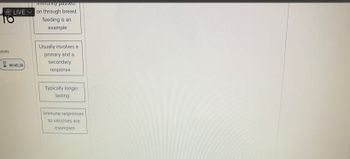
Human Anatomy & Physiology (11th Edition)
11th Edition
ISBN: 9780134580999
Author: Elaine N. Marieb, Katja N. Hoehn
Publisher: PEARSON
expand_more
expand_more
format_list_bulleted
Concept explainers
Question
What labels goes to active immunity and passive immunity

Transcribed Image Text:**Interactive Immunity Diagram**
**Labels:**
1. Can be an injection of serum that contains antibodies
2. Typically temporary
3. Depends on the presence of memory B cells and T cells
**Categories:**
- **Active Immunity (1/2)**
- **Passive Immunity (2/2)**
**Explanation:**
The image displays an interactive diagram related to the concept of immunity, where labels describing characteristics of immunity need to be matched to either "Active Immunity" or "Passive Immunity."
- **Active Immunity**: Involves the body's own production of antibodies and typically relies on memory B cells and T cells to recognize and combat pathogens. This type of immunity is long-lasting and developed after exposure to the antigen through infection or vaccination.
- **Passive Immunity**: Involves receiving antibodies from an external source, such as an injection of serum. This form of immunity is typically temporary and does not involve the body's own memory cells. It provides immediate protection but diminishes over time. Examples include maternal antibodies transferred to a newborn or administered antibodies for certain diseases.

Transcribed Image Text:### Immunity Types: Key Characteristics
1. **Immunity Passed Through Breastfeeding**
- *Example:* Immunity gained by infants from antibodies in breast milk.
2. **Involves Primary and Secondary Responses**
- *Details:* This type of immunity typically engages initially upon exposure and is boosted upon subsequent exposures.
3. **Typically Longer Lasting**
- *Characteristic:* Immunity that provides extended protection over time.
4. **Immune Responses to Vaccines**
- *Example:* How vaccines stimulate the body's immune response to offer protection against specific diseases.
Expert Solution
arrow_forward
Step 1
Immune response is the physiologial process which involves our body immune cells to identify and eliminate foreign materials, thereby preventing the organism from causing harm or developing disease to the host.
The first line of defence is physical barriers such as skin, saliva, tear and mucus, and also cells of innate immunity. The second line of defence includes the adaptive immunity, which are highly specific. The two types of active immunity are active immunity and passive immunity.
Step by stepSolved in 3 steps

Knowledge Booster
Learn more about
Need a deep-dive on the concept behind this application? Look no further. Learn more about this topic, biology and related others by exploring similar questions and additional content below.Similar questions
- In the above diagram, where do most immune cells accumulate? sub-mucosa and mesenteric plexus O lamina propria of mucosa O circulation O dorsal root ganglionarrow_forwardHow it works + detail if possiblearrow_forwardComplement is a cytokine that can self- activate to cause an innate immune response or complement can cause the activation of other cells like macrophages, mast cells, and dendritic cells. True Falsearrow_forward
- secondary immune response initial secondary exposure exposure primary immune response Time 2. Which response should be caused by vaccination? Concentration of antibodyarrow_forwardA mind map of HUMORAL IMMUNITY with 10 like words or phrasesarrow_forwardWhat is a lymphocyte central to adaptive immunity that targets infected or cancerous body cells? Macrophage Dendritic cell B cell T cellarrow_forward
arrow_back_ios
arrow_forward_ios
Recommended textbooks for you
 Human Anatomy & Physiology (11th Edition)BiologyISBN:9780134580999Author:Elaine N. Marieb, Katja N. HoehnPublisher:PEARSON
Human Anatomy & Physiology (11th Edition)BiologyISBN:9780134580999Author:Elaine N. Marieb, Katja N. HoehnPublisher:PEARSON Biology 2eBiologyISBN:9781947172517Author:Matthew Douglas, Jung Choi, Mary Ann ClarkPublisher:OpenStax
Biology 2eBiologyISBN:9781947172517Author:Matthew Douglas, Jung Choi, Mary Ann ClarkPublisher:OpenStax Anatomy & PhysiologyBiologyISBN:9781259398629Author:McKinley, Michael P., O'loughlin, Valerie Dean, Bidle, Theresa StouterPublisher:Mcgraw Hill Education,
Anatomy & PhysiologyBiologyISBN:9781259398629Author:McKinley, Michael P., O'loughlin, Valerie Dean, Bidle, Theresa StouterPublisher:Mcgraw Hill Education, Molecular Biology of the Cell (Sixth Edition)BiologyISBN:9780815344322Author:Bruce Alberts, Alexander D. Johnson, Julian Lewis, David Morgan, Martin Raff, Keith Roberts, Peter WalterPublisher:W. W. Norton & Company
Molecular Biology of the Cell (Sixth Edition)BiologyISBN:9780815344322Author:Bruce Alberts, Alexander D. Johnson, Julian Lewis, David Morgan, Martin Raff, Keith Roberts, Peter WalterPublisher:W. W. Norton & Company Laboratory Manual For Human Anatomy & PhysiologyBiologyISBN:9781260159363Author:Martin, Terry R., Prentice-craver, CynthiaPublisher:McGraw-Hill Publishing Co.
Laboratory Manual For Human Anatomy & PhysiologyBiologyISBN:9781260159363Author:Martin, Terry R., Prentice-craver, CynthiaPublisher:McGraw-Hill Publishing Co. Inquiry Into Life (16th Edition)BiologyISBN:9781260231700Author:Sylvia S. Mader, Michael WindelspechtPublisher:McGraw Hill Education
Inquiry Into Life (16th Edition)BiologyISBN:9781260231700Author:Sylvia S. Mader, Michael WindelspechtPublisher:McGraw Hill Education

Human Anatomy & Physiology (11th Edition)
Biology
ISBN:9780134580999
Author:Elaine N. Marieb, Katja N. Hoehn
Publisher:PEARSON

Biology 2e
Biology
ISBN:9781947172517
Author:Matthew Douglas, Jung Choi, Mary Ann Clark
Publisher:OpenStax

Anatomy & Physiology
Biology
ISBN:9781259398629
Author:McKinley, Michael P., O'loughlin, Valerie Dean, Bidle, Theresa Stouter
Publisher:Mcgraw Hill Education,

Molecular Biology of the Cell (Sixth Edition)
Biology
ISBN:9780815344322
Author:Bruce Alberts, Alexander D. Johnson, Julian Lewis, David Morgan, Martin Raff, Keith Roberts, Peter Walter
Publisher:W. W. Norton & Company

Laboratory Manual For Human Anatomy & Physiology
Biology
ISBN:9781260159363
Author:Martin, Terry R., Prentice-craver, Cynthia
Publisher:McGraw-Hill Publishing Co.

Inquiry Into Life (16th Edition)
Biology
ISBN:9781260231700
Author:Sylvia S. Mader, Michael Windelspecht
Publisher:McGraw Hill Education